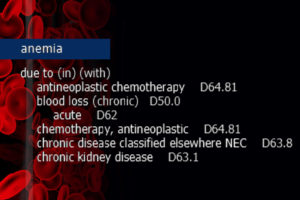Today’s Tip: Drug-induced Neuropathy
 Drug-induced neuropathy (D62.0) is a diagnosis often missed by even the savviest and seasoned coders. It is sometimes seen in documentation as ‘CIPN’ (chemotherapy-induced peripheral neuropathy) and is a common side effect caused by antineoplastic agents. Treatment includes steroids and nerve pain medication such as Gabapentin.
Drug-induced neuropathy (D62.0) is a diagnosis often missed by even the savviest and seasoned coders. It is sometimes seen in documentation as ‘CIPN’ (chemotherapy-induced peripheral neuropathy) and is a common side effect caused by antineoplastic agents. Treatment includes steroids and nerve pain medication such as Gabapentin.
Drugs related to neuropathy
The most likely chemotherapy drugs related to neuropathy include platinum drugs, such as oxaliplatin; taxanes, such as docetaxel; vinca alkaloids, such as vincristine; and myeloma treatments, such as bortezomib. This code can also be accompanied by another code for the adverse effect (T36-T50) to identify the drug.
Jeanie Heck, our Director of Education, begins our 2022 series of E/M Hot Topics with a discussion on Telemedicine. January’s Hot Topic provides an update from the CMS Final Rule as well as some reliable and reputable sources of information regarding telehealth.
For additional information about E/M Guideline Updates education, contact us.
Follow us on LinkedIn to keep up-to-date.
In our E/M Hot Topic discussions, we previously addressed the proper capture of Social Determinant of Health (SDOH) codes that can make a difference when determining the level of service for office visit codes. When used properly, they can impact the final MDM selection and subsequent reimbursement. In the November E/M Hot Topic, Jeanie Heck, our Director of Education, re-addresses this topic and reviews the new 2022 Chapter Specific Coding Guidelines for SDOH.
For additional information about E/M Guideline Updates education, contact us.
Follow us on LinkedIn to find out when the next E/M Hot Topic is released.
In September’s E/M Hot Topic, Jeanie Heck, our Director of Education at Intellis, discusses telehealth. The 2022 Medicare Physician Fee Schedule Proposed Rule proposes that CMS allow some telehealth services to remain on the list until the end of 2023. This is intended to help determine if some of the services should be permanently added to the telehealth list following the COVID-19 PHE. During this presentation, Jeanie reviews some trustworthy and reliable sites to reference regarding telehealth.
For additional information about E/M Guideline Updates education, contact us.
Follow us on LinkedIn to find out when the next E/M Hot Topic is released.
August 2021
In this month’s E/M Hot Topic, Jeanie Heck, our Director of Education, discusses “Drug Therapy Requiring Intensive Monitoring for Toxicity”. This falls under the HIGH level in our Risk element or level 5 (99205/99215). We now have a published definition for this in our 2021 CPT manual. This definition was further clarified by the CPT editorial panel in the Errata & Technical corrections document.
For additional information about E/M Guideline Updates education, contact us.
Follow us on LinkedIn to find out when the next E/M Hot Topic is released.
July 2021
In July’s E/M Hot Topic, Jeanie Heck, our Director of Education, discusses the new guidelines for Time and the Prolonged Time codes. The new 2021 E/M guidelines are significantly different from the way we previously used to account for Time. She also addresses the latest technical corrections regarding Time from the AMA’s webinar at the end of May and gives some documentation template examples to help educate your providers.
For additional information about E/M Guideline Updates education, contact us.
Follow us on LinkedIn to find out when the next E/M Hot Topic is released.
April 2021
With the use of the 2021 E/M Guidelines, questions continue to surface. In this month’s E/M Hot Topic, Director of Education, Jeanie Heck, BBA, CCS, CPC, CRC discusses Social Determinants of Health. She also provides an update to Prescription Drug Management and the Ordering/Review of Tests.
For additional information about E/M Guideline Updates education, contact us.
Follow us on LinkedIn to find out when the next E/M Hot Topic is released.
March 2021
As we continue to use the new 2021 E/M Guidelines, many questions continue to surface. In this month’s E/M Hot Topic, Director of Education, Jeanie Heck, BBA, CCS, CPC, CRC discusses the review and/or ordering of tests, independent interpretation of tests, and discussion of management or test interpretation from the data element of MDM.
For additional information about E/M Guideline Updates education, contact us.
The April 2021 E/M Hot Topic: Social Determinants of Health
Follow us on LinkedIn to find out when the next E/M Hot Topic is released.
Coding Tip
When anemia NOS is present as a current condition, and the patient has underlying chronic kidney disease (CKD) or end-stage renal disease (ESRD), it is a fast track to the usage of D63.1, Anemia in chronic kidney disease (manifestation). This is assigned unless the anemia is specified as a different form and/or attributed to another condition. Much like the diabetes category, ICD-10-CM “In/With” convention assumes “due to.”

ICD-10-CM Official Guidelines for Coding and Reporting FY 2021 Section I. A. 15.
“With”
The word “with” or “in” should be interpreted to mean “associated with” or “due to” when it appears in a code title, the Alphabetic Index (either under a main term or subterm), or an instructional note in the Tabular List. The classification presumes a causal relationship between the two conditions linked by these terms in the Alphabetic Index or Tabular List. These conditions should be coded as related even in the absence of provider documentation explicitly linking them, unless the documentation clearly states the conditions are unrelated or when another guideline exists that specifically requires a documented linkage between two conditions (e.g., sepsis guideline for “acute organ dysfunction that is not clearly associated with the sepsis”).
For conditions not specifically linked by these relational terms in the classification or when a guideline requires that a linkage between two conditions be explicitly documented, provider documentation must link the conditions in order to code them as related. The word “with” in the Alphabetic Index is sequenced immediately following the main term or subterm, not in alphabetical order.
Clinical Insight
Anemia refers to the reduction of the total number of circulating red blood cells. It is diagnosed when there is the detection of decreased hemoglobin concentration, hematocrit, or red blood cell count. Anemia in chronic kidney disease specifically falls under the category of decreased red blood cell production.
In CKD or ESRD, kidney function is compromised to the point that blood cannot be filtered of wastes and fluid. The kidneys also produce less erythropoietin (EPO), a hormone that signals the bone marrow to produce additional red blood cells. Furthermore, in CKD patients the red blood cells are not able to survive as long in the bloodstream and suffer a premature death. Due to associated nutrient deficiencies in underlying CKD, red blood cells are not reproduced as frequently or with the same cellular integrity as in a healthy patient.
Education Disclaimer: This coding tip is intended to serve the general community and may not account for all differences in coding routines, duties, or individual client policies. The information and opinions presented here are based on the experience, training, and interpretation of the author. Although the information has been researched and reviewed for accuracy, the instructor does not accept any responsibility or liability with regard to errors, omissions, misuse, or misinterpretation. This information is intended as a guide; it should not be considered a legal or consulting opinion or advice.
Keeping up with the annual updates and guidelines is a challenge for coding professionals and facility leaders. Intellis overcomes the challenge by providing tailored IQ Education that prepares coders on the frontlines to ensure their facilities are always ready for new rules.
Are you ready for October 1?
For the year 2021, ICD-10-CM official guidelines reflect over 500 significant changes. The updates include 490 new codes, 47 revised codes, and 58 codes deemed invalid. In addition, the upcoming fiscal year ICD-10-PCS code set includes 544 new codes and the recently released FY 2021 ICD-10-PCS Official Guidelines for Coding and Reporting. Effective date: October 1, 2020.
Find out more!
Right now, Intellis is offering robust training to help organizations prepare for FY 2021 ICD-10-CM, ICD-10-PCS updates. The sessions are presented by Intellis VP of Education & Training Kim Felix, RHIA, CCS a nationally recognized Intellis IQ subject matter expert.
We’re committed to helping coding teams prepare, and we provide personal service to make sure your education experience goes smoothly.
